
Baptism is a Christian sacrament of initiation almost invariably with the use of water. It may be performed by sprinkling or pouring water on the head, or by immersing in water either partially or completely, traditionally three times, once for each person of the Trinity. The synoptic gospels recount that John the Baptist baptised Jesus. Baptism is considered a sacrament in most churches, and as an ordinance in others. Baptism according to the Trinitarian formula, which is done in most mainstream Christian denominations, is seen as being a basis for Christian ecumenism, the concept of unity amongst Christians. Baptism is also called christening, although some reserve the word "christening" for the baptism of infants. In certain Christian denominations, such as the Catholic Churches, Eastern Orthodox Churches, Oriental Orthodox Churches, Assyrian Church of the East, and Lutheran Churches, baptism is the door to church membership, with candidates taking baptismal vows. It has also given its name to the Baptist churches and denominations.
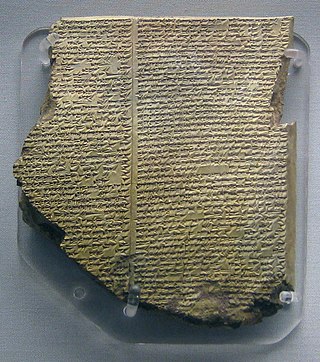
The Epic of Gilgamesh is an epic from ancient Mesopotamia. The literary history of Gilgamesh begins with five Sumerian poems about Gilgamesh, king of Uruk, some of which may date back to the Third Dynasty of Ur. These independent stories were later used as source material for a combined epic in Akkadian. The first surviving version of this combined epic, known as the "Old Babylonian" version, dates back to the 18th century BC and is titled after its incipit, Shūtur eli sharrī. Only a few tablets of it have survived. The later Standard Babylonian version compiled by Sîn-lēqi-unninni dates to somewhere between the 13th to the 10th centuries BC and bears the incipit Sha naqba īmuru. Approximately two-thirds of this longer, twelve-tablet version have been recovered. Some of the best copies were discovered in the library ruins of the 7th-century BC Assyrian king Ashurbanipal.

The Fountain of Youth is a mythical spring which supposedly restores the youth of anyone who drinks or bathes in its waters. Tales of such a fountain have been recounted around the world for thousands of years, appearing in the writings of Herodotus, in the Alexander romance, and in the stories of Prester John. Stories of similar waters also featured prominently among the people of the Caribbean during the Age of Exploration ; they spoke of the restorative powers of the water in the mythical land of Bimini. Based on these many legends, explorers and adventurers looked for the elusive Fountain of Youth or some other remedy to aging, generally associated with magic waters. These waters might have been a river, a spring or any other water-source said to reverse the aging process and to cure sickness when swallowed or bathed in.

The Ghent Altarpiece, also called the Adoration of the Mystic Lamb, is a very large and complex 15th-century polyptych altarpiece in St Bavo's Cathedral, Ghent, Belgium. It was begun around the mid-1420s and completed by 1432, and it is attributed to the Early Netherlandish painters and brothers Hubert and Jan van Eyck. The altarpiece is a prominent example of the transition from Middle Age to Renaissance art and is considered a masterpiece of European art, identified by some as "the first major oil painting."
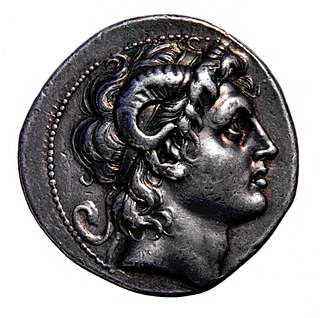
The story of Dhu al-Qarnayn is mentioned in Surah al-Kahf of the Quran. It has long been recognised in modern scholarship that the story of Dhu al-Qarnayn has strong similarities with the Syriac Legend of Alexander the Great. According to this legend, Alexander travelled to the ends of the world then built a wall in the Caucasus mountains to keep Gog and Magog out of civilized lands.
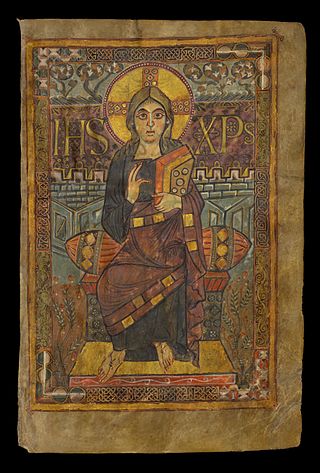
The Godescalc Evangelistary, Godescalc Sacramentary, Godescalc Gospels, or Godescalc Gospel Lectionary is an illuminated manuscript in Latin made by the Frankish scribe Godescalc and today kept in the Bibliothèque nationale de France. It was commissioned by the Carolingian king Charlemagne and his wife Hildegard on October 7, 781 and completed on April 30, 783. The Evangelistary is the earliest known manuscript produced at the scriptorium in Charlemagne's Court School in Aachen. The manuscript was intended to commemorate Charlemagne's march to Italy, his meeting with Pope Adrian I, and the baptism of his son Pepin. The crediting of the work to Godescalc and the details of Charlemagne's march are contained in the manuscript's dedication poem.
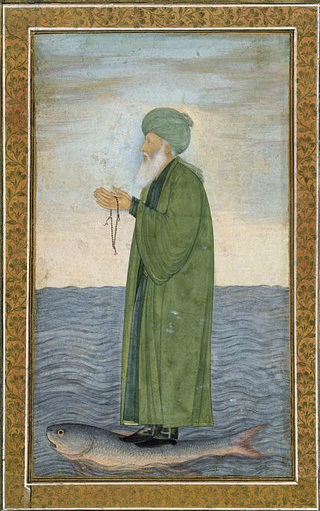
Al-Khidr is a figure not mentioned by name in the Quran. He is described in Surah Al-Kahf, as a righteous servant of God possessing great wisdom or mystic knowledge. In various Islamic and non-Islamic traditions, Khidr is described as an angel, prophet, or wali, who guards the sea, teaches secret knowledge and aids those in distress. He prominently figures as patron of the Islamic saint ibn Arabi. The figure of al-Khidr has been syncretized over time with various other figures including Dūraoša and Sorūsh in Iran, Sargis the General and Saint George in Asia Minor and the Levant, Samael in Judaism, Elijah among the Druze, John the Baptist in Armenia, and Jhulelal in Sindh and Punjab in South Asia. He is commemorated on the holiday of Hıdırellez.

The baptism of Jesus, the ritual purification of Jesus with water by John the Baptist, was a major event described in the three synoptic Gospels of the New Testament. It is considered to have taken place at Al-Maghtas, today located in Jordan.

The Alexander Romance, once described as "antiquity's most successful novel", is an account of the life and exploits of Alexander the Great. The Romance describes Alexander the Great from his birth, to his succession of the throne of Macedon, his conquests including that of the Persian Empire, and finally his death. Although constructed around an historical core, the romance is mostly fantastical, including many miraculous tales and encounters with mythical creatures such as sirens or centaurs. In this context, the term Romance refers not to the meaning of the word in modern times but in the Old French sense of a novel or roman, a "lengthy prose narrative of a complex and fictional character".

The Baptism of Christ is an oil-on-panel painting finished around 1475 in the studio of the Italian Renaissance painter Andrea del Verrocchio and generally ascribed to him and his pupil Leonardo da Vinci. Some art historians discern the hands of other members of Verrocchio's workshop in the painting as well.

Blood of Christ, also known as the Most Precious Blood, in Christian theology refers to the physical blood actually shed by Jesus Christ primarily on the Cross, and the salvation which Christianity teaches was accomplished thereby, or the sacramental blood (wine) present in the Eucharist or Lord's Supper, which some Christian denominations believe to be the same blood of Christ shed on the Cross.

The Casina Pio IV is a patrician villa in Vatican City which is now home to the Pontifical Academy of Sciences, the Pontifical Academy of Social Sciences and the Pontifical Academy of St. Thomas Aquinas. The predecessor of the present complex structure was begun in the spring of 1558 by Pope Paul IV in the Vatican Gardens, west of the Cortile del Belvedere. Paul IV commissioned the initial project of the 'Casina del Boschetto', as it was originally called, from an unknown architect; the first mention of the single-storey building can be found on 30 April 1558, and a notice of the following 6 May, says that the Pope spent "two thirds of his time at the Belvedere, where he has begun to build a fountain in the woods".
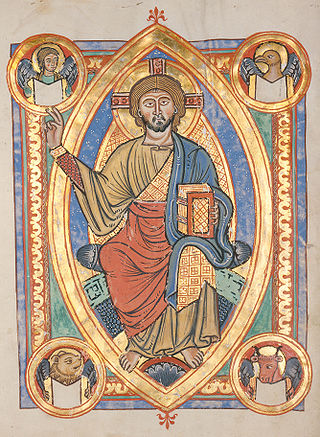
The Roman Catholic tradition includes a number of devotions to Jesus Christ. Like all Catholic devotions, these prayer forms are not part of the official public liturgy of the church but are based on the popular spiritual practices of Roman Catholics. Many are officially approved by the Holy See as suitable for spiritual growth but not necessary for salvation.

The vast conquests of the Macedonian king Alexander the Great quickly inspired the formation and diffusion of legendary material about his deity, journeys, and tales. These appeared shortly after his death, and some may have already begun forming during his lifetime. Common themes and symbols, among legends about Alexander include the Gates of Alexander, the Horns of Alexander, and the Gordian Knot.

Immersion baptism is a method of baptism that is distinguished from baptism by affusion (pouring) and by aspersion (sprinkling), sometimes without specifying whether the immersion is total or partial, but very commonly with the indication that the person baptized is immersed in water completely. The term is also, though less commonly, applied exclusively to modes of baptism that involve only partial immersion.

In Christianity the term "water of Life" is used in the context of living water, specific references appearing in the Book of Revelation, as well as the Gospel of John. In these references, the term Water of Life refers to the Holy Spirit.

In Reformed theology, baptism is a sacrament signifying the baptized person's union with Christ, or becoming part of Christ and being treated as if they had done everything Christ had. Sacraments, along with preaching of God's word, are means of grace through which God offers Christ to people. Sacraments are believed to have their effect through the Holy Spirit, but these effects are only believed to accrue to those who have faith in Christ.

The Fountain of Life or The Fountain of Grace and the Triumph of the Church over the Synagogue are names given to an oil on panel painting completed c 1432. For most of its history the painting has been in Spain, latterly in the Museo del Prado which recently featured it in a special exhibition. Stylistically and thematically, the painting is related to the work of Jan van Eyck, but it is unsigned and there have been competing theories as to whether it is by van Eyck himself.
The Song of Alexander is a Christian Syriac text written between the 6th and 7th centuries AD concerning legends about Alexander the Great. It had been falsely attributed nearly unanimously in the manuscript tradition to Jacob of Serugh (451–521), and for this reason, the author is sometimes referred to as Pseudo-Jacob. It is also presently thought to have been written closely after and have been influenced by the Syriac Alexander Legend, and so its date is closely tied to when the latter is dated.
Alexander the Great was the king of the Kingdom of Macedon and the founder of an empire that stretched from Greece to northwestern India. Legends surrounding his life quickly sprung up soon after his own death. His predecessors represented him in their coinage as the son of Zeus Ammon, wearing what would become the Horns of Alexander as originally signified by the Horns of Ammon. Legends of Alexander's exploits coalesced into the third-century Alexander Romance which, in the premodern period, went through over one hundred recensions, translations, and derivations and was translated into almost every European vernacular and every language of the Islamic world. After the Bible, it was the most popular form of European literature. It was also translated into every language from the Islamicized regions of Asia and Africa, from Mali to Malaysia.



















